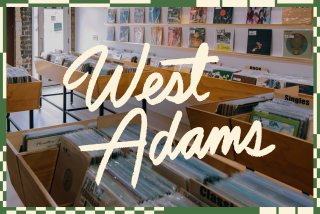Collage of Historic Homes Hidden in Highland Park
- Share via
Viewing the Ebinger House, prominently sited on the side of a steep hill in Highland Park, it is easy to envision the area northeast of downtown as the comfortable suburb it once was.
The Tudor-styled, brown-and-biege house at 369 N. Avenue 53 is a rambling, three-story, Craftsman-designed structure that was built in 1913. Numerous other Craftsman-inspired structures are scattered throughout Highland Park which, from about 1890 to 1930, was one of the city’s more desirable communities.
While the houses were spared the wrecking ball, many were abused, as well as shoved aside and shadowed by new construction. The result is that Highland Park is a frayed collage of a community, with some fine houses of historic interest elbow-to-elbow with ticky-tacky apartment developments and crass commercial complexes.
It is this history and these houses that are prompting a rising community consciousness in Highland Park, making the area a battleground for zoning and land-use reforms, and a new frontier of sorts for urban pioneers.
Housing is relatively affordable there, with desirable California bungalows that cost $300,000 and up in Pasadena going for $75,000 to $150,000 in Highland Park.
“It is a great place for starter homes for families,” Diane Garcia of the Highland Park Neighborhood Assn. said. “And for preservationists too,” said Virginia Neely of the Highland Park Heritage Trust.
The fledgling spirit of the community will be on display Sunday, Jan. 24, on a tour and restoration workshop of six historic homes, including the Ebinger House. Sponsored by the Heritage Trust with an assist from the Los Angeles Conservancy, the tour begins at the Southwest Museum’s Casa de Adobe, 4603 N. Figueroa St., and runs from noon to 4:30 p.m.
Advance reservations are suggested. For tickets, $20 for Trust and Conservancy members; $30 for the public, contact the Conservancy at (213) 623-CITY.
Of course, the Ebinger House--with its towering Sequoia--and most of the homes on the tour can be viewed anytime from the street. The problem is finding the clusters of historic homes tucked away in the community’s numerous nooks and crannies.
The Tustin and Beach-Johnson houses on the tour are located in an area known as Sycamore Terrace, along a lane labeled Figueroa Street. It is accessible just west of the intersection of Figueroa Street and Avenue 50 and runs along the crest of an embankment there.
The street used to be known as Professor’s Row because many of the teachers who lived there taught at what was once the campus of Occidental College (just north of Avenue 50). The street also has been labeled Craftsman Row after the style of the bungalows there, most of which survive.
The Tustin House at 4973 Figueroa St. is an excellent example of a Japanese-inspired bungalow, replete with ornate rafters. It was built in 1912, much in the spirit of a Greene and Greene design. Recently saved from demolition, it is undergoing restoration. Two other redwood-shingle bungalows of note are the Herivel and Johnson houses, at 4979 and 4985.
The Beach-Johnson House, at 4939, is a delightful, modest cottage constructed in 1892 of stones hauled up from the river bed of the nearby Arroyo Seco. Further down the lane as it weaves south to meet a curving Figueroa Street are a few other flavorful period houses.
Also featured on the tour will be the Griffith House, an eclectic mix of Craftsman detailing and Colonial Revival styling, topped off with a Moorish arch over the porch. It is located at 5915 Echo St., amid a cluster of other houses representing an encyclopedic range of architectural styles.






